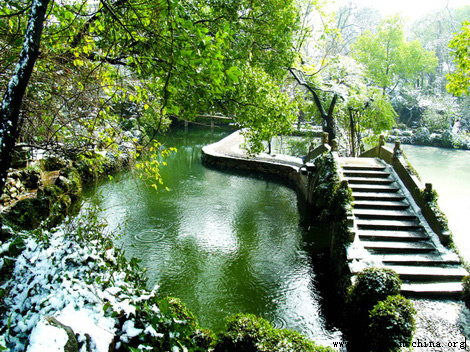| Home > Living In China |
Travel to Tibet
Time flows with eternity, in spite of sunshine, mist, rainbow and snow, leaving our timeless memories on this soil of Tibet. Holding a reverence in nature, we set our sights on the different seasons of Tibet. January in Lhasa: Stepping into the sunshine Courage is absolutely the first thing if you travel to Tibet in winter, considering the freezing weather in January. In inland areas snow and cold waves keep people at home all the day. Tibet, nearest to the sun, however, witnesses crowds of people enjoying leisure time under the sun, drinking tea while chatting and laughing. The scene, warm and casual, often makes travelers forget time and where they are. Statistics show that Lhasa has an average annual sunshine of more than eight hours a day. You can wear only a woollen sweater at noon under the sun in Lhasa even in winter. February in Lhasa: Celebrating three festivals It's such a coincidence that three festivals, the Tibetan New Year, the Spring Festival and the Valentine's Day, fall on the same day - Feb. 14 this year. Traveling in Tibet on that special day will certainly be an once-in-a-life experience. The Spring Festival and Valentine's Day are undoubtedly great events, let alone the Tibetan New Year. The celebration of the Tibetan New Year begins on Dec. 29 on the Tibetan calendar, lasting 15 days. March in Nyingchi: Enjoying peach blossoms Nyingchi is a sea of peach blossoms in March, like crimson clouds hovering in the embraces of snowy mountains. Wild peach trees can be seen everywhere along the banks of the Nyang River in Nyingchi. Taohua Village(or Peach-blossom Village) is the best choice for enjoying peach blossoms. April is not the best time to visit the Namtso Lake for tourists. However, the ice-thawing Namtso Lake presents a rare scenery for most people. May in Lhokha: Shelter forest along the Yarlung Tsangpo River The 150-km shelter forest along the Yarlung Tsangpo River serves as a green protective screen for the river. Viewed from the sightseeing plane, the scenery of the river and the forest resembles an impressionist oil painting. The Samye Temple, peaceful and mysterious, along the bank of the Yarlung Tsangpo River is another option for tourists. Xigaze usually welcomes the Lingka Woods Festival in June, which is different from Lhasa where the festival is celebrated in July and August. The Children's Day, on June 1, is also nicknamed "the Lingka Woods Festival"since adults and children enjoy the best days of a year in the period. Xigaze covers a vast territory and as a result has a variety of weather phenomena. The area is usually covered by green grass and trees in June, with everyone enjoying the festival, which can even match the Shoton Festival. The Sichuan-Tibet Route boasts the most gorgeous route to Tibet, as well as the most dangerous one. July, also before the rainy season starts, is the best time for tourists to travel through the route to Tibet. The route includes the south line and the north one, diverging in Xindu Bridge, known as "a paradise for photographers." The two lines have the following most beautiful places in China named by the magazine of Chinese National Geography: Dampa Mountain Village, one of the six most beautiful villages; Midui Galcier, one of the six most beautiful glaciers; Lingzhi Spruce Forest, one of the ten most beautiful forests; Namjiagbarwa Peak and Gonggar Snow Mountain, two of the most beautiful snow mountains. Tired of the urban life, tourists should not forget the Horse Festival in Nagchu. Viewing the grassland and an endless skyline, tourists can forget the boredom. Cheering with the heroes on the horsebacks, travelers can relax in the natural world. Nagchu, also famous for its yoghourt and jerked yak meat, is a place to get rid of your burden. September in Ngari: the destination of your soul The Earth Forest in Tsada County is regarded as a world wonder by the tourists. The wilderness soon catches tourists' hearts when they see the Earth Forest extending far to the horizon. The forest seems to be comprised of castles, pagodas and earth trees, unique and majestic. A tourist says: "No matter how far we go, the destination we long for is the rest place of our soul. Ngari is the rest place of my soul." Ngari also has some other famous tourist sites, such as the Mapham Yutso Lake, the holy Mountain of Kangrinboqe, the Lannga Co Ghost Lake, the Pangong Tso Lake, the Tsada Toding Monastery and the ruins of Guge Kingdom. The Hengduan Mountains are magnificent and beautiful with fall getting closer in October's Chamdo, where three rivers meet, namely, the Jinsha River, the Lantsang River and the Nu River. Khampa culture is the core point of Chamdo tourism, with intangible cultural heritage like Shinze dance, Repa dance in Dengqen County and Tibetan Opera. Chamdo also is dotted with cultural relics, such as Karub ruins, Yanduo ruins, Lessor Enda site and Sengezong ruins. Also, the ancient Saltern in Yanjing County, the folk houses in Sanyan area of Gongjo County and culture of the Tea Horse Trail all build up the reputation of Chamdo. November in Nyingchi: simple life in the Yarlung Tsangpo Grand Canyon The tourist sites in the Yarlung Tsangpo Grand Canyon include the canyon itself, the Namjiagbarwa Peak -- one of the most beautiful mountains in China, the Medog County-the only area inaccessible to roads. Appreciating the golden yellow forests and the Namjiagbarwa Peak, tourists will be touched by the simplicity of life. They can spend some days resting in the Zhibai Village at the foot of the peak to enjoy the sunrise and sunset. Breathing the fresh air and eating the simplest food, tourists can rise with the sun and sleep with the moon there, chewing the happiness of life. Lhasa, at an altitude of 3,700 meters, attracts thousands of birds for its wetlands. Many species of birds, such as black-necked cranes and bar-headed geese, fly to Lhasa to live through the winter. The Lhalu Wetland and the Hutou Reservoir in the Lhunzhub County are both nice choices for bird watching. If you love the black-necked cranes, you should definitely go to the Lhunzhub County in December or January, where birds present a unique landscape of Tibet.
Tibet, a place of mystery and sanctity, is witnessing its coldest days this winter.
An undated photo shows girls are having a good time in Nyingchi County during the peach flower festival.
When spring comes to Nyingchi in March, it is great time to watch peach blossoms.
April in Namtso: ice-thawing Namtso Lake
An undated photo shows tourists doing sightseeing by the Namtso Lake.
June in Xigaze: Lingka Woods Festival
July on the Sichuan-Tibet Route
File photo shows the earth forest in the Tsada County of Ngari Prefecture, western Tibet.
August in Nagchu: Horse Festival on Changtang Grassland
October in Chamdo: Pearl in eastern Tibet
An undated photo shows a group of black-necked cranes flying in the Maizhokunggar County, Tibet's capital of Lhasa.
December in Lhasa: watching the birds
Custom
 more
moreWeb Dictionary
Primary&secondary
Beijing National Day School
Beijing Concord College of Sino-Canada
Brief Introduction of BCCSC Established in the year 1993, Huijia School is a K-12 boarding priva...Beijing Huijia Private School





 print
print  email
email  Favorite
Favorite  Transtlate
Transtlate 







